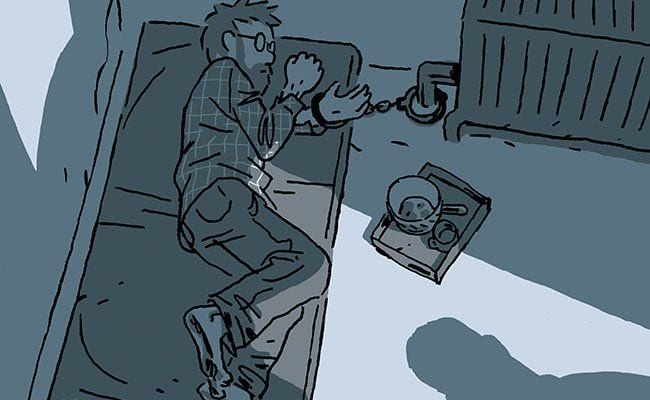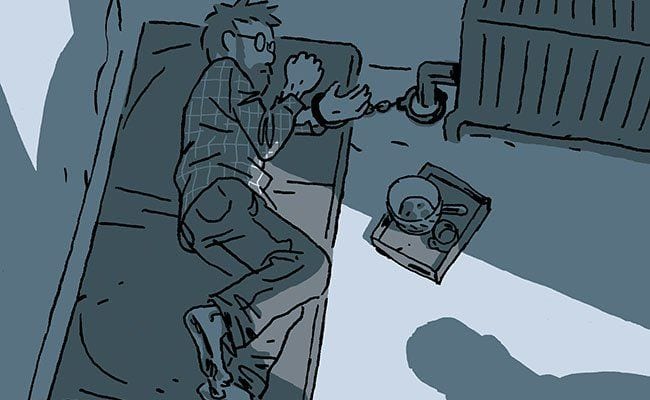
At its best, nonfiction gives readers a glimpse at an unknown truth. Facts are harsh. Hostages are taken for ransom, prisoner exchanges, or simply to embarrass a nation. News stories give us the facts about numbers, days in captivity, and attempts at negotiation. Sometimes we see hostages huddled away into what looks like a safe vehicle, and to all but those directly related, the end of the story.
Maybe a victim-of-the-week movie will try to cover the story by parlaying some overused trope to garner a marginal rating and a few tears. Hostage offers a very different story where silence and freedom have the capacity to break down a person’s mind, leaving him forever out of step with the world around him.
The long form graphic novel tells the story of Cristophe André who went to work with Doctors Without Borders in a Russian republic. This book documents his kidnapping and long confinement as a hostage in Chechnya. If I tell you the basics of the story, it might sound uninteresting. A reader might think sequential art would never be able to do the harsh lack of action justice.
July, 1997: André, left alone in the annex where he works, is taken hostage hostage in the middle of the night. His captors smuggle him across the border into Chechnya where, over several months, they keep him handcuffed in a series of rooms. He cannot communicate with his captors who speak a different language, and he remains unsure whether someone on the outside is trying to negotiate his release. We follow André’s experience as he waits for his meals, is taken for toilet breaks, and gets lost in his thoughts as he tries to stay strong and sane.

How could an illustrator, dare I say “cartoonist”, make this lack of plot transcend the facts to offer some unknown truth? Simple: he creates a rhythmic narrative that seems half epistolary and half stream-of-consciousness as it marks one man’s descent in a void where silence and closed doors make “freedom” seem as dangerous as sneaking in front of a firing squad.
Much of the sequential art has been structured in a minimalist style that creates a focused sense of space and light. Many panels offer slightly varying panels of the same image with different grades of shading, establishing both time and perception that mimics André’s mental and physical condition. Imagine sitting, chained in place watching the light from a window move across the wall. Delisle constructs that sense of both time and confinement by isolating the singular visual perception for the reader. Panels often seem murky in deep gray tones where walls become darker and faces have no identifiable features. Darkness becomes analogical for the haze of André’s mind and the literal lack of light.
Much of André’s mental monologue takes place in his imagination as he separates himself from his confinement. He thinks through battles in military history and recites the biographical details of the leaders. In Delisle’s panels, André mentally constructs models of the battles by Napoleon and of the U.S. Civil War, yet the hostage can make no connection between his military knowledge to his current condition. Historical military actions and political acts in Chechnya cannot be clearly established as direct metaphors. The agendas of the current conflicts seem too personal and the acts cannot be explained through military strategies or traditional political agendas.
André has a few moments during his captivity where he can choose to try an escape or remain a prisoner, but he gets trapped in the logic of inaction finding reason and purpose, losing the chance in the process. Staring across the room at a closed door becomes a metaphor of indecisions and threat. Delisle creates a mental struggle that somewhat crosses Dalton Trumbo’s Johnny Got His Gun (1971) with Foucault’s Panopticon. A man, chained in a room, closed off from the world must exist in his mind. He cannot communicate, and instead of trying, he makes his lack of communication a protective weapon. He wants, maybe needs, a to feel a human connection or at least to feel the sun on his skin, but his world has been dictated by his captors.
André’s logic stands at odds with his needs, so he stays defiant by withholding communication. There is no one watching him as he stays chained behind closed doors, but he never knows what might be waiting on the other side. There may be guards waiting for his escape attempt, or just a child playing ball. André lives in the dark, feels too hot or too cold, and worries with the steel band around his wrist. If he tries to escape, how bad will he suffer if he cannot get past the phantom who waits between him and the outside world? He exists in a limbo: neither a political prisoner nor a convict.
Delisle constructs an emotional truth. When André decides to invoke the climax to his own story, we have learned to think like a hostage through the purposeful panels that accentuate the stress and emotional emptiness of extended confinement. By creating empathy through desire and fear, Hostage leaves us to question if we would want to open the door and feel the pain of freedom.

